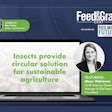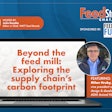Concerns about animal welfare and food safety from governments, downstream customers and consumers have put added pressure on feed industry stakeholders to ensure the consistency, quality and safety of animal feed. As we look to the future, the spotlight on animal feed safety is set to intensify, potentially heralding a new era of stringent regulations and heightened scrutiny. Third-party feed safety certification programs offer feed producers the knowledge, protocols and credibility to secure their relationships and reputation.
GMP+ International's GMP+ Feed Certification (GMP+ FC) is the largest global feed safety scheme, with more than 19,000 GMP+ certified companies in more than 87 countries. The organization provides feed manufacturers with uniform standards and knowledge sharing (GMP+ Feed Safety Assurance); corporate sustainability guidelines (GMP+ Feed Responsibility Assurance); and the opportunity for feed industry stakeholders to contribute to feed safety worldwide by facilitating, sharing and securing knowledge. (GMP+ Academy).
After 30 years with GMP+ International, its managing director Johan den Hartog has retired, passing the torch to Roland van der Post. In all, den Hartog has served the European and international animal feed sector for more than 40 years.
Den Hartog joined the Chat to reflect on how far feed safety protocols have come and how he believes they will evolve in the future.
Transcription of Feed Strategy Chat with Johan den Hartog, retired managing director, GMP+ International
Jackie Roembke, editor in chief, WATT Feed Brands/Feed Strategy: Hi, everyone. Welcome to Feed Strategy Chat. I’m your host, Jackie Roembke, editor in chief of WATT Feed Brands and Feed Strategy magazine.
This edition of Feed Strategy Chat is brought to you by WATT Global Media and FeedStrategy.com. FeedStrategy.com is your source for the latest news and leading-edge analysis of the global animal feed industry.
Today we’re joined on Zoom by Johan den Hartog, former of head of GMP+ International. The GMP+ Feed Certification scheme is the largest and most widely recognized feed safety scheme in the world, with over 19,000 GMP+ certified companies in over 87 countries.
After 13 years as its managing director, Johan retired this year and started his consultancy JDH Management & Consulting. He’s here today to reflect on how far feed safety protocols have come and how they will evolve in the future.
Hi, Johan, how are you today?
Johan den Hartog: Hello, fine. It's OK. I'm enjoying my retirement.
Roembke: Thank you so much for being here. Let's get right into it. During your tenure, what would you say were the most notable feed safety advances?
Den Hartog: When I look back at the last 30 years — [GMP International] started in 1982 in the Netherlands — I think the most important result is the shift of the mindset, a paradigm shift, you could say. In the beginning, there was no awareness about feed safety, no awareness about the [industry's] responsibility for it, and the result now is that more and more companies worldwide realize they have a responsibility for feed safety and they have to act on it.
The lesson we learned is that not only is it a responsibility to the farmers, the animal, the livestock farms, but also to the whole supply chain. Every company in the supply chain should take responsibility for their products. I think that is the most important lesson we learned, and that is also the result we have now achieved. Not everywhere, but in many countries, people realize a [safety] certificate is not a marketing tool. It is a tool to control their own feed safety risks — risks in the process as well as in the feed supply chain. That enables the companies to create trust in the market, and that gives them better access to the market and a better relationship with their customers.
Roembke: Great. Thank you for that. Today, what are the main safety challenges?
Den Hartog: I think climate change is a real challenge. Maybe the possibility of mycotoxins that can occur. Weather conditions can change and are not always easy to predict — maybe it can be dry or it may very rainy.
The lack of a regular [ingredient] supplies, as we've learned, due to the pandemic, but also due to conflicts like we have now in Ukraine. People realize that imports of products cannot be supplied at times. Companies then look for other sources and buy from lesser-known suppliers, which can result in higher risk. Of course, it's important that companies realize it and take action. But, of course, when you have a regular supplier with a clear control system you can rely on it, but if you switch to other suppliers, it can result in a bit more risk.
These are the two main issues I can recognize.
Roembke: What are the solutions for feed manufacturers when it comes to those two main challenges?
Den Hartog: When it's about mycotoxins, of course, monitoring — monitoring the weather conditions in the most important regions of supply, monitoring samples and by testing in the early states — maybe already before the harvest occurs.
When it's about a lack of regular supply, you can look for how to reduce your dependency on one or two suppliers. Look around for where you find more suppliers so that you can reduce the risk of these disruptions.
Roembke: How do you think food safety will evolve in the future?
Den Hartog: The products will change, the processes change, the climate will change, but I think in the future, we will see more new products — and it's important to be aware of the related feed safety risks and to have a clear feed safety risk assessment in advance.
What's also important for the future is a growing need of dissemination of knowledge about feed safety. We noticed that and as a result we established GMP+ Academy. We know that people know something about GMP, but not how to implement it and why to implement it. It's really important not only for the mill managers, but also for all people at all levels in the company. So that's very important. So dissemination around the world, but also dissemination within the company and to all people in the company.
In many countries, feed safety is an important issue, more or less common practice, but I think that's mainly companies that deliver products to customers abroad. In Europe, the local domestic customers demand it, but in many countries — in Asia, Latin America and Southern Europe — it is not black and white. I expected in the future [increasingly] in these parts of the world, feed safety will become more important for domestic markets — from the governmental side, but also from the retail side, where feed safety is a common issue. Also, as incomes rise, the people in these countries will become more critical and able to ask questions like, "How safe is my food?" and that will result in more potential for food safety in those domestic markets.
Roembke: What new technologies do you feel could further reduce the feed safety risks and improve feed safety systems?
Den Hartog: I think we are now in a very interesting time with many new developments in technology. One of them is blockchain, which can also increase trust in the chain with traceability. Also what we call "internet of things," sensors in the production line so you can monitor the process and the other parameters that have an impact on the feed safety.
Also, the rapid testing methods can be interesting. They will increase the possibility to test more frequently at a lower cost and maybe also in the earlier states.
All kinds of techniques now enable creation of predictive learning, predictive models. For instance, with mycotoxins, when you have some parameters with weather conditions, maybe they can predict the possibility of increased levels of mycotoxins that will occur from a certain area of origin.
These techniques can help companies in the future to have a better control the feed safety.
Roembke: Right. From a food safety perspective, what could the feed mill of the future look like?
Den Hartog: Digital monitoring in the production line — sensors in the production line, machine learning enabling data collection from the production process. Then traceability and blockchain will give better visibility in the supply chain, but also in the feed mill and more precise traceable visibility inside the company. That's all important and, of course, help improve feed safety.
What I learned from the feed facility suppliers and the feed equipment suppliers, they have the potential, for instance, to implement automated cleaning systems and procedures in the production line. I think these kinds of technologies will become more and more important for the feed mill in the future.
And last, but not least, how to reduce energy use, how to use renewable energy, and how to minimize waste. Sustainability is also important for the future.
Roembke: Yeah, absolutely. Well, thank you so much for those insights. Now, what are you up to now in your retirement with your consultancy?
Den Hartog: First of all, I have some more time for myself and my family. Secondly, I also some time to volunteer.
I am available part of my time for business development, consultancy and strategic advising to companies or organizations based on my experience in the past. I'm two weeks into retirement, so I have to reflect and to get used to my new situation.
Roembke: If someone wants to reach you, how can they do that?
Den Hartog: They can send an email to me, but you can find it on my LinkedIn account, which is my name. Send a message and I can get you into contact with people who would like to talk about my services.
Roembke: Very good. If you would like more information about GMP+ International, please visit www gmpplus.org. Thank you so much, Johan. Congratulations on your retirement. And thanks to you for tuning in.
Den Hartog: You're welcome. Bye, bye.

















